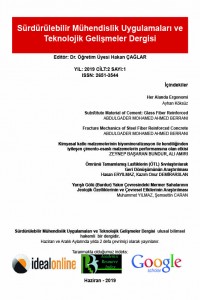Abstract
Şehirlerimizi oluşturan binaların cepheleri, binaları hava ve su gibi fiziksel etkileşimlerden korurken, aynı zamanda binaya prestij katmaktadır. Binaların iç tasarımı sadece kullanıcıları tarafından bilinmekle birlikte, cepheleri şehri kullanan herkes tarafından algılanmaktadır. Cephe tasarımları özellikle mimarlar için çok önemlidir. Mimarlar, binalarını farklı bina cephe tasarımları ile kentte farkedilebiliyor. Bu bağlamda, farklı renkler, desenler, dokular ve eğriler (tek, çift ve serbest) sağlayan cam elyaf takviyeli beton cepheler bu talepleri büyük ölçüde karşılayabilir. Birçok ünlü mimar veya tasarımcı tarafından tercih edilen paneller hizmet ömrü, darbe dayanımı, üretim kalitesi ve üretim hızı ile ön plana çıkıyor. Bu çalışmada, cam elyaf betonarme uygulama alanları, sağladığı biçimsel olasılıklar, avantajlar ve dezavantajlar incelenecektir.
Keywords
References
- Reference1
Abstract
The facades of the buildings that make up our cities protect the buildings from physical interactions such as air and water, while at the same time they add prestige to the building. While the interior design of the buildings is known only by their users, their facades are perceived by everyone who uses the city. Facade designs are very important especially for architects. Architects aim to make their buildings noticeable in the city with their different building facade designs. In this context, glass fiber reinforced concrete facades which provide different colors, patterns, textures and curvatures (single, double and free) can meet these demands to a great extent. The panels preferred by many famous architects or designers come to the forefront with its service life, impact resistance, production quality and production speed. In this study, the application areas of glass fiber reinforced concrete, the formal possibilities, advantages and disadvantages it provides will be examined.
References
- Reference1
Details
| Primary Language | English |
|---|---|
| Journal Section | Articles |
| Authors | |
| Publication Date | June 15, 2019 |
| Submission Date | February 10, 2019 |
| Acceptance Date | April 2, 2019 |
| Published in Issue | Year 2019 Volume: 2 Issue: 1 |
Creative Commons Lisansı
Bu eser Creative Commons Atıf 4.0 Uluslararası Lisansı ile lisanslanmıştır.


